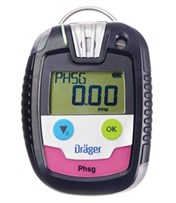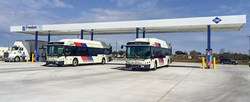New in gas processing technology
Scavenge sour gas from production streams
Sour gas in oil and gas production streams can increase production costs, impact employee safety, endanger asset integrity and adversely impact the surrounding environment. To help oil and gas producers scavenge sour gas effectively, SUEZ has formulated a new version of its ProSolv HS line to effectively scavenge H2S without phase separation upsets that affect water quality and salt in condensate.
ProSolv HS is a non-nitrogen-based chemistry that does not impact downstream refining processes. It is safer to deploy compared to nitrogen-containing scavengers, which adversely impact refining processes with the formation of salts and costly corrosion. ProSolv HS is injected with similar dose rates to the amine-based chemistries, allowing the use of existing infrastructure and pumping capabilities.
Sour gas is natural gas that contains significant amounts of acidic gases, such as H2S and CO2. Increased H2S levels in process streams prevent
operators from processing and selling these streams in a cost-effective manner.
The ProSolv HS series includes a non-amine-based chemistry that scavenges H2S from the process stream without creating any side effects to the downstream process. The new technology offers a range of solutions with cleaner processes and without precipitation to ensure a smooth separation with no process upsets.
Nitrogen-containing scavengers (such as Triazines) produce scale deposition, resulting in pipeline pressure buildup that causes safety concerns, shutdowns, deferred production and expensive unplanned maintenance to clean the scale buildup. Gas fuel
for Port Houston
Freedom CNG has laid the foundation for the cleaner air initiative and the #DrivingCleanerAir campaign. As it relates to Port Houston, from drayage to transloading to warehousing, the port has seen a year-over-year increase in container volume leading to a trucking logistics industry boom.
In response, Freedom CNG has installed fast-fill, truck-friendly compressed natural gas (CNG) fueling stations to serve public and private fleets. Replacing diesel with clean CNG has an immediate positive impact on air quality and the bottom line. CNG is abundant, powerful and cost-effective.
Personal gas monitors enhance worker safety
 |
With Pac 6000, 6500, 8000 and 8500, Dräger offers a new series of personal single-gas monitors. The monitors detect not only the standard gases carbon monoxide (CO), hydrogen sulfide (H2S), sulfur dioxide (SO2) and oxygen (O2) (Pac 6000 and 6500), but also special gases, such as ozone, phosgene and nitrogen dioxide (Pac 8000 and 8500). In addition, Pac 8500 is available with a dual sensor for H2S/CO or O2/CO, and a hydrogen-compensated CO sensor. This significantly reduces the influence of H2 on the indication of CO.
Since quick and reliable gas measurement is extremely important in an industrial environment, the monitors of the Pac series provide fast, precise and reliable results, and are easy to operate. Users can choose between 18 long-life sensors for up to 33 gases. The industrial battery used in the monitors enables a service life of 2 yr without a battery change. Existing accessories can also be used with the new monitors.
The integrated “D-Light” shows the user whether the monitor is functional and ready for operation. In addition to the present gas concentration, the large display provides other important information, such as battery capacity, target gas and remaining service life.
The Pac series can also withstand harsh operating conditions. The sensors can be used in a temperature range of –40°C–55°C. An easily replaceable membrane filter protects the sensor against foreign substances, such as dust or liquids. The impact- and chemical-resistant housing meets the requirements of IP68. Each sensor variant is identified by a color code, which makes mix-ups practically impossible.
Pac series monitors display the respective highest concentration measured. Alarms are issued acoustically, optically and with perceptible vibration, and users can access acknowledged alarms at a later time.
Combined solution identifies pipeline corrosion and geometry defects
In 2017, an operator was in need of an inspection of several installations in a natural gas pipeline. Located in a desert, the pipeline system consisted of nine different pipeline sections with 24-in. diameters and a total length of 990 km.
The client suspected the presence of various types of anomalies, including general corrosion and geometry defects. Since the client expected to find a variety of anomalies in the pipeline system, ROSEN provided a combined diagnostic solution. The modular technology design allowed for unlimited combinations of ROSEN’S individual services. This modularity is supported by standardized mechanics and electronic interfaces.
The solution was based on a combination of three technologies—MFL-A, XT and XYZ—in one inline inspection run. The RoCorr MFL-A unit is capable of identifying metal loss defects, such as general corrosion and circumferential anomalies; the RoGeo XT unit identifies geometric anomalies; and the RoGeo XYZ unit gathers data on pipeline location and bending strain.
Furthermore, ROSEN conducted an additional RoCorr MFL-C inspection run to identify axial defects. Inspection data gathered from the two successful inline inspections using four different technologies were used as input for a combined data analysis. ROSEN integrity engineers were able to gain a clear picture of the various defects present in the pipeline, enabling them to provide the operator with a complete and accurate assessment of the integrity status of the pipeline system.
Customer benefits of the combined-solution inspection included improved sizing accuracy and probability of identification by combining complementary inspection technologies and aligned data sets, improved characterization of interacting defects and reduced impact on pipeline operations. Cost-effectiveness and reduction of operational risks were also achieved by limiting onsite activities.
Gas fuel for Port Houston
 |
Freedom CNG has laid the foundation for the cleaner air initiative and the #DrivingCleanerAir campaign. As it relates to Port Houston, from drayage to transloading to warehousing, the port has seen a year-over-year increase in container volume leading to a trucking logistics industry boom.
In response, Freedom CNG has installed fast-fill, truck-friendly compressed natural gas (CNG) fueling stations to serve public and private fleets. Replacing diesel with clean CNG has an immediate positive impact on air quality and the bottom line. CNG is abundant, powerful and cost-effective.
LAI applied to exploration and production
Total and Google Cloud have signed an agreement to jointly develop artificial intelligence (AI) solutions for application to subsurface data analysis for oil and gas exploration and production.
The agreement focuses on the development of AI programs that will make it possible to interpret subsurface images, notably from seismic studies (using Computer Vision technology), and to automate the analysis of technical documents (using Natural Language Processing technology).
These programs will allow Total’s geologists, geophysicists and reservoir and geo-information engineers to explore and assess oil and gas fields faster and more effectively. Under this partnership, Total geoscientists will work side-by-side with Google Cloud’s machine learning experts within the same project team based in Google Cloud’s Advanced Solutions Lab in California.
Total started applying AI to characterize oil and gas fields using machine learning algorithms in the 1990s. In 2013, Total used machine learning algorithms to implement predictive maintenance for turbines, pumps and compressors at its industrial facilities, thereby generating savings of several hundred million dollars. Today, Total teams are exploring multiple machine learning and deep learning applications, such as production profile forecasting, automated analysis of satellite images and analysis of rock sample images.




Comments